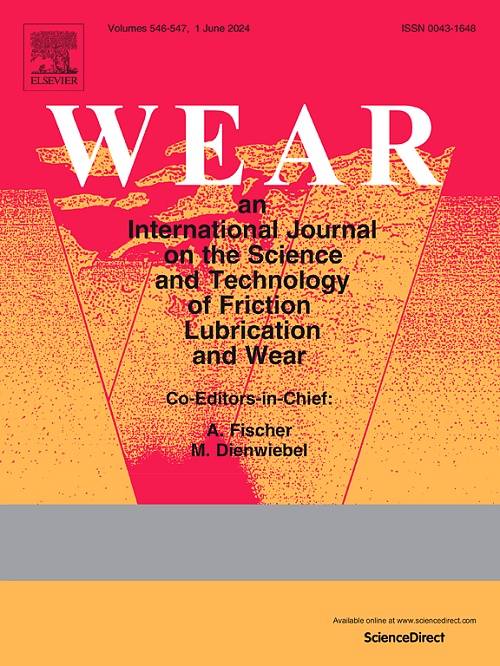An experimental investigation on tribological performance of L-PBF Ti6Al4V: Influence of build orientation and post-processing
IF 6.1
1区 工程技术
Q1 ENGINEERING, MECHANICAL
引用次数: 0
Abstract
Laser powder bed fused (L-PBF), additively manufactured (AM), titanium alloys are prone to anisotropic effects that pose a setback for their practical applications. This study explores the variations in tribological properties of Ti6Al4V with different printing conditions such as build orientation and height. A height difference of 30 mm unveiled a lower wear resistance in the top samples (30 mm print height) compared to the bottom samples (near the base plate). A detailed analysis of different loads (20 N–200 N) applied showed more aggressive abrasive wear and delamination when the load was increased above 80 N. The horizontally oriented components demonstrated dominant plastic deformation and delamination on the wear surface while dominant abrasive wear marks and ploughing action were observed on the vertically built samples. Analysis based on different post-processing routes including stress relieving, heat treatments, and cryogenic treatments, for better tribological performance indicates the suitability of cryogenic soaking which showed a 3.01 % lower wear rate in the vertical orientation and 11.74 % lower in the horizontal orientation against the normal stress relieving treatments. Different heat treatments (400 °C, 700 °C, 1090 °C), cryogenic soaking (-196 °C), and their combinations were performed to monitor the wear behavior and furthermore, conventionally forged samples were also tested under similar conditions for a comparison purpose.
L-PBF Ti6Al4V摩擦学性能的实验研究:构建取向和后处理的影响
激光熔粉床(L-PBF)、增材制造(AM)、钛合金容易产生各向异性效应,这对其实际应用造成了阻碍。本研究探讨了Ti6Al4V的摩擦学性能在不同打印条件下的变化,如构建方向和高度。与底部样品(靠近底板)相比,30毫米的高度差揭示了顶部样品(30毫米打印高度)的耐磨性较低。对不同载荷(20 N - 200 N)的详细分析表明,当载荷增加到80 N以上时,磨料磨损和脱层现象更为严重。水平取向的部件在磨损表面表现出主要的塑性变形和脱层,而垂直构建的样品则表现出主要的磨料磨损痕迹和犁削作用。通过对应力消除、热处理和深冷处理等不同后处理路线的分析,表明深冷浸泡比常规的应力消除处理更适合获得更好的摩擦学性能,其垂直方向的磨损率降低3.01%,水平方向的磨损率降低11.74%。采用不同的热处理(400°C、700°C、1090°C)、低温浸泡(-196°C)及其组合来监测磨损行为,此外,还对常规锻造样品在类似条件下进行了测试,以进行比较。
本文章由计算机程序翻译,如有差异,请以英文原文为准。
求助全文
约1分钟内获得全文
求助全文
来源期刊

Wear
工程技术-材料科学:综合
CiteScore
8.80
自引率
8.00%
发文量
280
审稿时长
47 days
期刊介绍:
Wear journal is dedicated to the advancement of basic and applied knowledge concerning the nature of wear of materials. Broadly, topics of interest range from development of fundamental understanding of the mechanisms of wear to innovative solutions to practical engineering problems. Authors of experimental studies are expected to comment on the repeatability of the data, and whenever possible, conduct multiple measurements under similar testing conditions. Further, Wear embraces the highest standards of professional ethics, and the detection of matching content, either in written or graphical form, from other publications by the current authors or by others, may result in rejection.
 求助内容:
求助内容: 应助结果提醒方式:
应助结果提醒方式:


